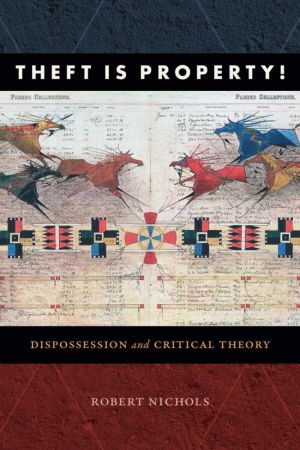Theft Is Property!
Dispossession and Critical Theory
by Robert Nichols
DescriptionTable of ContentsDetailsHashtagsReport an issue 






Book Description
Drawing on Indigenous peoples' struggles against settler colonialism, Theft Is Property! reconstructs the concept of dispossession as a means of explaining how shifting configurations of law, property, race, and rights have functioned as modes of governance, both historically and in the present. Through close analysis of arguments by Indigenous scholars and activists from the nineteenth century to the present, Robert Nichols argues that dispossession has come to name a unique recursive process whereby systematic theft is the mechanism by which property relations are generated. In so doing, Nichols also brings long-standing debates in anarchist, Black radical, feminist, Marxist, and postcolonial thought into direct conversation with the frequently overlooked intellectual contributions of Indigenous peoples.This open book is licensed under a Creative Commons License (CC BY-NC-ND). You can download Theft Is Property! ebook for free in PDF format (13.1 MB).
Table of Contents
Chapter 1
That Sole and Despotic Dominion
Chapter 2
Marx, after the Feast
Chapter 3
Indigenous Structural Critique
Chapter 4
Dilemmas of Self-Ownership, Rituals of Antiwill
Book Details
Title
Theft Is Property!
Subject
History
Publisher
Duke University Press
Published
2020
Pages
249
Edition
1
Language
English
ISBN13
9781478006732
ISBN10
1478006730
ISBN13 Digital
9781478007500
ISBN10 Digital
1478007508
PDF Size
13.1 MB
License

Related Books

This book analyses intellectual property and innovation governance in the development of six key industries in India and China. These industries are reflective of the innovation and economic development of the two economies, or of vital importance to them: the IT Industry, the film industry, the pharmaceutical industry, plant varieties and food sec...

With technology standards becoming increasingly common, particularly in the information and communications technology (ICT) sector, the complexities and contradictions at the interface of intellectual property law and competition law have emerged strongly. This book talks about how the regulatory agencies and courts in the United States, European U...

This open access edited book captures the complexities and conflicts arising at the interface of intellectual property rights (IPR) and competition law. To do so, it discusses four specific themes: (a) policies governing functioning of standard setting organizations (SSOs), transparency and incentivising future innovation; (b) issue of royalties fo...

The authors of this book advise the economies of the European Union to become more entrepreneurial in promoting innovation and economic growth. The authors propose a reform strategy with respect to several aspects to achieve this goal. Starting with the rule of law and the protection of property rights; the tax system; the authors deal with regulat...

Offering key insights into critical debates on the construction, management and destruction of heritage in Muslim contexts, this volume considers how Islamic heritages are constructed through texts and practices which award heritage value. It examines how the monolithic representation of Islamic heritage (as a singular construct) can be enriched by...

This manuscript discusses the potentials of the approaches as mentioned below to monitor the AIVs in WMW. Molecular diagnostic platforms enable for accurate detection of the AIVs in the feces of infected birds. Similar technologies can be used to determine the bird species through DNA barcoding, enabling non-invasive research on the epidemiology of...

